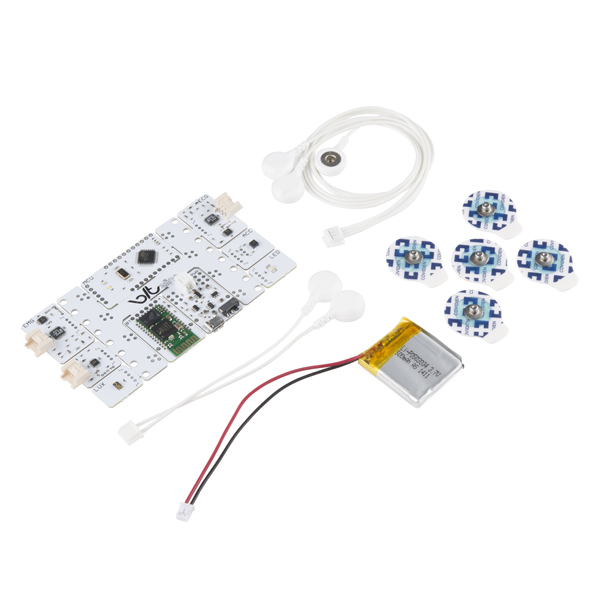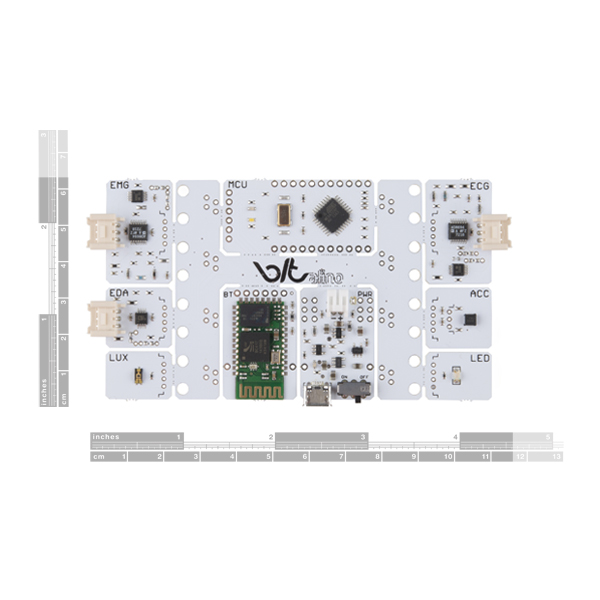×
SparkFun will be closed on Tuesday, December 24th, and Wednesday, December 25th, in observance of the Christmas holiday. Any orders qualifying for same day shipping placed after 2:00 p.m. (MST) on Monday, December 23rd, will be processed on Thursday, December 26th, when we return to regular business hours. Wishing you a safe and happy holiday from all of us at SparkFun!
Please note - we will not be available for Local Pick up orders from December 24th-December 27th. If you place an order for Local Pick-Up we will have those ready on Monday, December 30th.
BITalino - BioMedical Development Kit
Introducing the BITalino, a (comparatively) low cost biomedical data acquisition dev board that allows you to create projects using physiological sensors and tools. Each BITalino is presented in a "ProtoSnap style" making it able to be programmed as a whole board or snapped apart for use in future projects. This dev board also has no shortage of programming APIs which include Python, Java, Android, and more.
The BITalino is equipped with nine removable "blocks" which can be used straight out-of-the-box and include an MCU, Bluetooth, Power, EMG, EDA, ECG, Accelerometer, LED, and Light Sensor! At the heart of this dev board is the tried and true ATMega328 micro-controller that can be configured with a sampling rate up to 1000Hz and capable of supporting six analog inputs (four at 10-bit, two at 6-bit), four digital inputs, and four digital outputs. With the attached BC417 Bluetooth module, triaxial MEMS accelerometer, and physiological sensor inputs will find it difficult to run out of ideas for projects.
In the Documents section below you will will find a link for OpenSignals, a new software that empowers your BITalino. OpenSignals allows you to playback your previously recorded sessions and zoom in and out of specific periods, plug in architecture available for future optional add-ons to help you analyze your signals, customize transfer function definitions, and more.
Note: The BITalino only communicates via Bluetooth with your computer.
Note: Due to the requirements of shipping the battery in this kit, orders may take longer to process and therefore do not qualify for same-day shipping. Additionally, these batteries can not be shipped via Ground or Economy methods to Alaska or Hawaii. Sorry for any inconvenience this may cause.
Included on the Board:
- Micro-Controller Block
- Power Block
- Electromyography Block (EMG)
- Electrodermal Activity Block (EDA)
- Electrocardiogram Block (ECG)
- Lux Block
- Accelerometer Block
- Bluetooth Block
- LED Block
- 1x BITalino Board
- 1x 3-lead accessory (for EMG / ECG)
- 1x 2-lead accessory (for EDA)
- 5x Pre-gelled electrodes
- 1x Li-Po Battery (3.7V, 500mAh)
- Datasheet (BC417)
- Hardware Manual
- OpenSignals
- Product Page
- GitHub (Application Example Code)
- Product Video
BITalino - BioMedical Development Kit Product Help and Resources
Core Skill: Programming
If a board needs code or communicates somehow, you're going to need to know how to program or interface with it. The programming skill is all about communication and code.
Skill Level: Competent - The toolchain for programming is a bit more complex and will examples may not be explicitly provided for you. You will be required to have a fundamental knowledge of programming and be required to provide your own code. You may need to modify existing libraries or code to work with your specific hardware. Sensor and hardware interfaces will be SPI or I2C.
See all skill levels
Core Skill: Electrical Prototyping
If it requires power, you need to know how much, what all the pins do, and how to hook it up. You may need to reference datasheets, schematics, and know the ins and outs of electronics.
Skill Level: Rookie - You may be required to know a bit more about the component, such as orientation, or how to hook it up, in addition to power requirements. You will need to understand polarized components.
See all skill levels
Comments
Looking for answers to technical questions?
We welcome your comments and suggestions below. However, if you are looking for solutions to technical questions please see our Technical Assistance page.
Customer Reviews
3.7 out of 5
Based on 3 ratings:
Bitalino
It's a nice kit, very usefull
There is a problem in the python api example
There was a problem in the python example code. With their help, I got the python example to work.
I am now trying to get the C++ example to run. There is a problem. I am on day five trying to get both the python and C++ code supplied by Bitalino to run.





You can get the schematics here. http://repositorio.ipl.pt/bitstream/10400.21/3293/1/Disserta%C3%A7%C3%A3o.pdf
The design is a little crude, and the results will probably be a lot noiser than they could be. This sort of biomedical instrumentation requires good analog design and layout, appropriate use of filters and appropriate power supply and ground design in order to get good results amplifying and acquiring these small, delicate signals without drowning them in noise. Significant improvements can probably be obtained with nearly negligible increases in existing BOM cost. Here are some idea and suggestions to think about.
All analog and digital power supplies and grounds should be separated. The designers have sort of recognised this a little bit, but it could be better.
There is not one single decoupling capacitor on the analog power supply in the EDA, ECG and EMG analog modules!!
Good filtering and decoupling on the analog Vcc rails to the analog stages should be used, with the separate analog power supply derived from the main power supply rail with LC filtering.
These sorts of systems often benefit from a narrow band-reject notch filter at 50Hz or 60Hz depending on country, to remove hum from the power grid.
I would probably use an external 12-bit ADC with a good independent voltage reference source, for example an MCP3208 connected to the microcontroller over SPI, rather than relying on the AVR's internal 10-bit ADC and internal voltage reference.
I would use a star ground layout where the analog-side ground and the digital-side ground are only joined at one point, at the ADC.
Red Pitaya???
For those of us who don't deal with this every day, I looked up "VAT", as I had no clue.. I assume this (or something close) is what you mean: https://en.wikipedia.org/wiki/Value_added_tax
The Github source page link is broken. https://github.com/bitalino
I get a 404 error from Github.
Fixed, thanks
Wow! Nearly as expensive as real medical devices but not FDA approved and not covered by Obamacare. .
They're 220 USD (159 Euro) on their store, and that's with shipping to US 30-dat (~6 Euro/10 USD) and also without VAT it seems... They estimate tax to be zero
EDIT Continuing all the way to pay pal check out it's 155 euro
Is there going to be a schematic for this available? Or at least let us know what the chip is for the ECG and all that, I'm in need of a good ECG circuit but not looking for the whole kit, just a little too much for the project its going into.
hodginsa - I spent 20 years designing ECGs and intracardiac electronics. If you want/need some good circuits for ECG look at analog.com and the TI.com websites. Both have very good sections on ECG and biomedical electronics in general. The circuitry is not that difficult to design and build, it is all of the nuances necessary to make and keep it safe for the person to whom it is connected that are the biggest hurdles. The IEC60601-1 and IEC60601-2 series of standards cover this stuff, but they are not readily available on line.
"it is all of the nuances necessary to make and keep it safe for the person to whom it is connected"
Ah, but that's the beauty of self experimentation - the subject is expendable, and in the case of a fatality, the researcher is beyond the reach of any official inquiries. ; )
The biggest issue I've seen with most home built ECGs is noise, but I certainly would not power one with anything but a low voltage battery supply. A "mains" supply might seem like a great convenience, that is, until the day the Chinese manufactured wall wart decides to couple 120vac across your chest.
"The most frequent last words of a redneck are: 'Hey y'all, watch this...'" - Jeff Foxworthy
A significant portion of the cost is VAT. Several times I have decided not to buy things from EU suppliers due to the very high VAT.
Am pretty sure that SparkFun got this without the euro-zone VAT. You don't have to pay VAT when exporting from the euro-zone, most EU-suppliers subtract this automatically and/or you can claim the ~20% back.
What's the costly part of this? I'm curious about why the price is so high.
Maybe the software it comes with...
We'll probably find out in a few hours when the release the friday new product post.